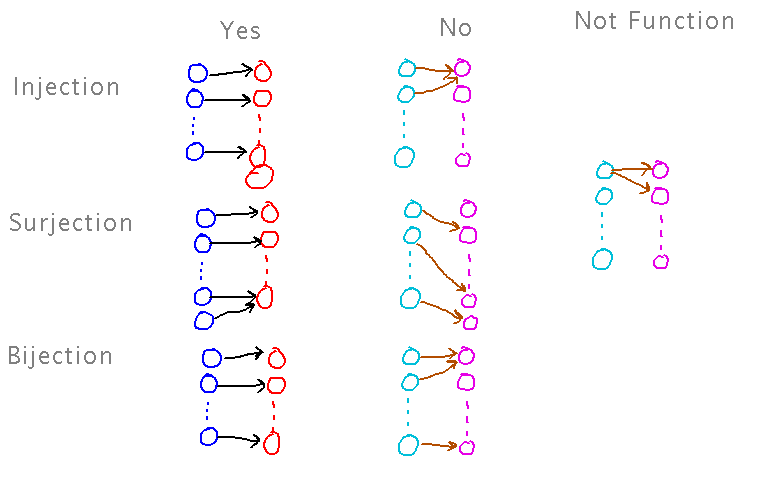Misc
GREAT Day is next Wednesday (April 17).
Lots of math talks and posters; go see them (and other things, too).
Extra credit for writing reactions/reflection on any one math-related presentation.
Questions?
Injections, Surjections, Bijections
Section 6.3.
Definitions
Sketch arrow diagrams for stereotypical injection, surjection, bijection, and for examples of key disqualifying features.

Proofs
Consider f : ℕ → D, where D is the set of odd natural numbers, defined by f(n) = 2n - 1.
Prove that f is an injection, surjection, and bijection.
Formal versions of these proofs are here, with LaTeX source here. The following are outlines of the proof ideas.
Injection
Proof 1, by contradiction: assume a ≠ b but f(a) = f(b), so
2a -1 = 2b - 1
2a = 2b
a = b
...which is a contradiction because a ≠ b.
Proof 2, via the contrapositive: assume f(a) = f(b), show a = b
2a -1 = 2b - 1
2a = 2b
a = b
QED.
Notice that this uses the same algebra as the contradiction proof, but in a slightly more direct way.
Surjection
Let y be in D, and show there’s an n such that y = f(n) = 2n - 1. If y = 2n - 1 then...
2n = y + 1
n = (y+1)/2
Check: f((y+1)/2) = 2(y+1)/2 - 1 = y+1 - 1 = y.
Bijection
Immediate because f is an injection and a surjection.
Key Points
Definitions of injection, surjection, and bijection.
Prove that a function is an injection by showing that f(a) = f(b) implies a = b
Prove that a function is a surjection by showing that a generic element of its codomain has a preimage. This is essentially choose-an-element.
Prove that a function is a bijection by proving it is an injection and a surjection.
Composition
The composition of functions f and g is f(g(x)), often written f ∘ g.
Not too suprisingly, if f and g are injections, surjections, and/or bijections, so is f ∘ g. (These are all theorems that can be proven.)
Next
Inverses of functions.
Read section 6.5